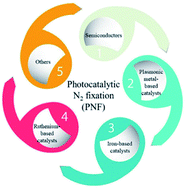A minireview on catalysts for photocatalytic N2 fixation to synthesize ammonia
Abstract
Ammonia (NH3) is an important feedstock in chemical industry. Nowadays NH3 is mainly produced via the industrialized Haber–Bosch process, which requires substantial energy input, since it operates at high temperatures (400–650 °C) and high pressures (20–40 Mpa). From the energy conservation point of view, it is of great significance to explore an alternative avenue to synthesize NH3, which is in line with the concept of sustainable development. Very recently, photocatalytic N2 fixation (PNF) has been discovered as a safe and green approach to synthesize NH3, as it utilizes the inexhaustible solar energy and the abundant N2 in nature to synthesize NH3 under mild conditions. A highly efficient catalyst is the core of PNF. Up to now, extensive studies have been conducted to design efficient catalysts for PNF. Summarizing the catalysts reported for PNF and unraveling their reaction mechanisms could provide guidance for the design of better catalysts. In this review, we will illustrate the development of catalysts for PNF, including semiconductors, plasmonic metal-based catalysts, iron-based catalysts, ruthenium-based catalysts and several other catalysts, point out the remaining challenges and outline the future opportunities, with the aim to contribute to the development of PNF.

- This article is part of the themed collection: 2022 Reviews in RSC Advances


 Please wait while we load your content...
Please wait while we load your content...